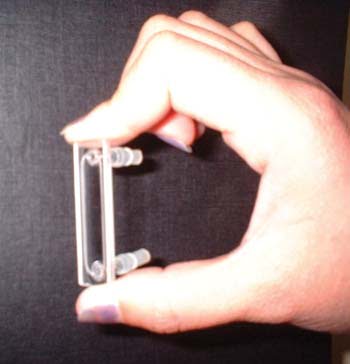Hank Hogan, Contributing Editor
Iron isn’t just the stuff of nails, girders or rusting cans. It also plays a role in climate and in the ocean’s food chain. In regions of water far removed from iron-bearing soil dust, dissolved oceanic iron is a limiting factor in the growth of phytoplankton, which are central not only to the ocean’s food chain, but also to the global climate. To understand more about the roles played by phytoplankton, researchers would like to know how much iron is contained in seawater in iron-poor regions, such as the Southern Ocean surrounding Antarctica.
“The ideal technique can be used onboard ship to make direct in situ measurements,” said David A. Russell, a professor in the school of chemical sciences and pharmacy at the University of East Anglia in Norwich, UK.
Unfortunately, existing methods are far from ideal. Iron concentrations in the Southern Ocean are low — about 50 pM — and vary by depth. Current measurement techniques require some form of sample pretreatment, which makes onboard measurement difficult. Russell and his colleagues at the university, therefore, began work on a new iron sensor based on fluorescence quenching.
To use iron, microorganisms produce reversible binding agents called siderophores. Russell’s group selected a siderophore named parabactin that is extracted from the bacterium Paracoccus denitrificans because it has a high binding constant for iron (III) — the bioavailable form of the metal — and because iron quenches its fluorescence, providing a signal when binding occurs.
To complete the biosensor, the group encapsulated the parabactin in a transparent sol-gel matrix that permitted seawater to reach the siderophore while enabling it to undergo the structural change needed to capture iron.
Using a fluorometer from Instruments SA Inc. (now Horiba Jobin Yvon), a spectrophotometer from Hitachi and a quartz flow cell, the researchers measured absorption and fluorescence spectra of parabactin in various solutions and in response to various dissolved ions. With an excitation wavelength of 311 nm, they found fluorescence at 460 nm in the water, with the exact location of the peak dependent upon the pH. When they pumped dissolved iron (III) through the flow cell, the fluorescence intensity at 460 nm decreased and, from this, they determined a calibration curve. The lower detection limit was 40 pM, with a relative standard deviation of 6 percent.


This flow cell includes an iron-binding siderophore encapsulated in a sol-gel. The siderophore captures iron from seawater that flows through the cell and quenches the siderophore’s fluorescence, providing an iron-concentration measurement potentially suitable for use onboard an oceangoing vessel. Courtesy of David A. Russell, University of East Anglia.
After verifying that their measured values compared well with those of a reference sample, they used the technique to look at bioavailable iron concentration versus depth in North Atlantic Ocean samples. They found that the concentration increased from <100 pM at the surface — where the iron is consumed by photosynthesis — to as much as 1000 pM below the surface. This profile was in agreement with those of other techniques. They report their findings in the July 15 issue of Analytical Chemistry.
Russell said that the ultimate goal is to put the biosensor onboard a research vessel and to collect data in oceans that have low iron (III) concentrations. However, he noted that more work must be done before the sensor takes to the high seas. “We would like to improve on the reproducibility,” he said.
Contact: David A. Russell, School of Chemical Sciences and Pharmacy, University of East Anglia; e-mail: [email protected].